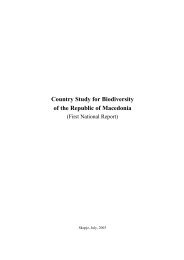CBD Fourth National Report - Azerbaijan (English version)
CBD Fourth National Report - Azerbaijan (English version)
CBD Fourth National Report - Azerbaijan (English version)
You also want an ePaper? Increase the reach of your titles
YUMPU automatically turns print PDFs into web optimized ePapers that Google loves.
Country Study on Biodiversity and <strong>Fourth</strong> <strong>National</strong> <strong>Report</strong><br />
The Republic of <strong>Azerbaijan</strong><br />
recommended for inclusion in the second edition of the <strong>Azerbaijan</strong> Red Data Book. Of<br />
particular note are the carnivores, as a number of carnivore species are thought to be locally<br />
extinct due to hunting and habitat change (for example striped hyena, Caucasian leopard and<br />
wild cat) all rare from Nakhichevan during the last century. Nearly a quarter of mammal<br />
species occurring in <strong>Azerbaijan</strong> have naturally restricted ranges, as a result of the relic nature<br />
of the populations, specific habitat requirements, or the species being at the edge of their<br />
range.<br />
I volume (on vertebrate) of the Red Book of Nakhichevan Autonomous Republic was<br />
published in 2006. 71 species of vertebrate were included in this Book. 1 specy of them refers<br />
to fish class, 1 specy to amphibia, 10 species of reptiles, 39 species of birds and 20 species of<br />
mammals. Lists of rare plant and animal species being under danger in Nakhichevan<br />
Autonomous Republic are specified in Appendix 3, Annex 3.1).<br />
1.1.6. Key threats to biodiversity<br />
1.1.6.1. Habitat loss and modification<br />
Land Con<strong>version</strong><br />
The major cause of biodiversity loss in <strong>Azerbaijan</strong> is the decrease in natural environments.<br />
This decrease has been due to human (anthropogenic) activities changing or destroying<br />
natural habitats. Industry and construction has had an extensive impact on natural habitats.<br />
For example, construction on the Absheron Peninsula has reduced the area of natural and<br />
unspoilt habitats, and as a result has caused a decrease in the biological diversity on the<br />
peninsula.<br />
As a result of political events, about 250,000 people fled from Armenia to <strong>Azerbaijan</strong>, and<br />
more than 700,000 people were displaced from the land occupied by Armenia. These people<br />
were settled in towns, temporary camps, hostels and incomplete buildings. New settlements<br />
have been constructed in order to improve the way of life for these people, but not all people<br />
could be resettled. Lack of public amenities is causing both health and environmental<br />
problems in these areas.<br />
Land degradation<br />
A major ecological problem in <strong>Azerbaijan</strong> is the gradual degradation of agricultural land. At<br />
present 3.6 million ha of land are subject to erosion. The soil of large areas of land is also<br />
becoming salinated. At present 1.5 million ha of land has been salinated to the extent that it is<br />
no longer suitable for agriculture. Salination and erosion of soils tend to be a result of poor<br />
irrigation and drainage systems, ground water extraction and wood cutting. In addition, the<br />
location of refugee and displaced persons settlements near river-banks and canals can degrade<br />
the integrity of the channels.<br />
Grazing by cattle has affected large areas of natural grassland habitats, and has contributed to<br />
soil erosion. Overgrazing by cattle reduces the amounts of plant matter available to other<br />
natural herbivores in the environment, thus decreasing their numbers and changing the<br />
dynamics of the community. Overgrazing can also cause the local extinction of plants in<br />
some areas.<br />
Loss of forests is also contributing to soil erosion and land degradation. Forest cover provides<br />
a protective function to surrounding lands, without it the soils become exposed and erode, and<br />
flooding onto neighbouring lands contributes to further soil erosion.<br />
39<br />
2009

















